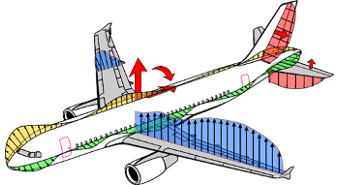Virtual Aircraft
 Copyright: Airbus
Copyright: Airbus
The "Virtual Aircraft" use case employs reduced order modeling and dimensionality reduction methods to provide a digital description of an aircraft in terms of its characteristics and properties based on a limited set of large-scale high-fidelity simulations. This provides an attractive approach to reduce computational cost while providing accurate answers to support design decisions and to perform quick trade studies. Also, methods for minimizing the number of simulations needed to extract the Virtual Aircraft model from simulation data are of interest. Data classification methods are of interest to gain more physical insight, e.g., to identify (aerodynamic) nonlinearities and to track how they evolve over the design space and flight envelope. The Virtual Aircraft use case will lead to Scientific Big Data Analytics (SBDA) techniques from other fields of research being evaluated for extracting relevant information from high-fidelity numerical and experimental data and for merging heterogeneous data to arrive at a more consistent, homogenous digital aircraft model. The Virtual Aircraft use case will also contribute a range of methods for data fusion, surrogate and reduced-order modeling to the generic methods that can be applied to the use cases of other partners. The software and SBDA methods to set up the Virtual Aircraft can be developed in such a generic fashion that it will be possible to adapt them to other fields of research that deal with product virtualization.
This use case is contributed by the German Aerospace Center (DLR).
Last updated: 06 Mar 2018
 Copyright: Airbus
Copyright: Airbus
 Copyright: Airbus
Copyright: Airbus